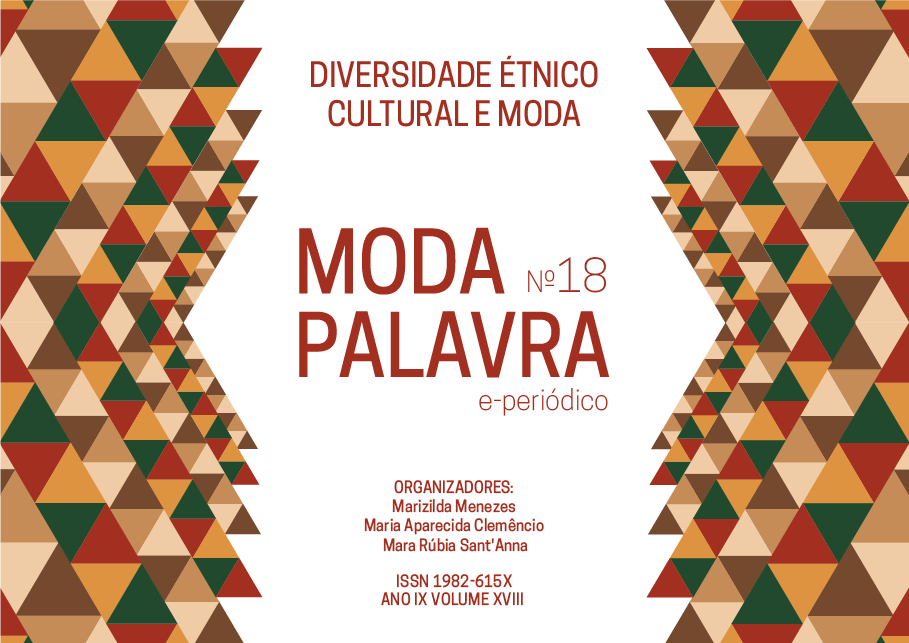Traditional costume: contemporary elements in street culture
DOI:
https://doi.org/10.5965/1982615x09182016057Keywords:
costumes, ethnic groups, contemporaneityAbstract
The article discusses the memory of the costumes and the way people record and interpret their relations with them. This is on the assumption that we put ourselves at all, and for that reason, too, the popular costumes reveal the political place of eachsubject on the Festa de São Benedito in Congada de Ilhabela -manifestation of African descent culture chosen to treated in this text. This study aimed to understand the role of costume in the composition of the cultural identity of black ethnic-racial group of Ilhabela, to point out how a seemingly simple costume can reveal so many meanings for the group in question. The Congada de Ilhabela is the devotion of a population to a saint; holy and black people who resisted the many prejudices and deep social and economic transformations. Therefore, the expression of that culture and tradition invented by means of a negotiated identity will be discussed. Regarding the costume, the study will be based on material culture and participant observation conducted withthis population between the years 1995 to 2002.
Downloads
References
BRANDÃO, Carlos Rodrigues. A cultura na rua. 2ª. Edição. Campinas, SP: Papirus, 2001.
GAUDITANO, Rosa; TIRAPELI, Percival. Festas de Fé. São Paulo: Metalivros, 2003.
GONÇALVES, José Reginaldo Santos. Antropologia dos objetos: coleções, museus e patrimônio. Rio de Janeiro: Coleção Museu, Memória e Cidadania, Minc/Iphan/DMCC, 2007.
HALBWACHS, Maurice. A memória coletiva. São Paulo: Vértice, 1990.
HOBSBAWM, Eric & RANGER, Terence. A invenção das tradições. Rio de Janeiro: Paz e Terra, 1984.
ITALIANO, Isabel et al. Para vestir a cena contemporânea: moldes e moda no Brasil do século XIX. São Paulo: Estação das Letras e Cores, 2015.
LOPES, Nei. Bantos, malês e identidade negra. Rio de Janeiro: Forense Universitária, 1988.
MERLO, Márcia. Entre o mar e a mata: a memória afro-brasileira. São Sebastião, Ilhabela e Ubatuba. São Paulo: FAPESP: EDUC, 2005.
______________. Memória de Ilhabela: faces ocultas, vozes no ar. São Paulo: EDUC: FAPESP, 2000.
NOROGRANDO, Rafaela. Como é formado o patrimônio cultural. Estudo museológico em Portugal na temática Traje/Moda, dissertação de mestrado em Antropologia Social e Cultural, orientada por Nuno Porto e Kathia Castilho, Departamento de Ciências da Vida, Universidade de Coimbra, Coimbra, Portugal, 2011.
BENJAMIN, Walter. “O narrador. Considerações sobre a obra de Nikolai Leskov”. In: Magia e técnica, arte e política: ensaios sobre literatura e história da cultura. Tradução de Sérgio Paulo Rouanet. São Paulo: Brasiliense, 1994. (Obras Escolhidas; v. 1).
MERLO, Márcia. Congada de Ilhabela: o santo, o homem, a festa, o negro e o lugar. IN: Revista Ângulo 127, Set./Dez., 2011, p. 46-53.
MONTERO, Paula. “Globalização, identidade e diferença”. In: Novos Estudos CEBRAP, nº 49. São Paulo: Cebrap, 1997, p. 47-64.
POLLAK, Michael. “Memória, esquecimento, silêncio”. In: Estudos Históricos –Memória, Rio de Janeiro, v. 2, n. 3, 1989, pp. 3-15.
_______________. “Memória e identidade social”. In: Estudos Históricos –Teoria e História, Rio de Janeiro, Vol. 5, nº 10, 1992, pp. 200-212.
http://culturadigital.br/construindoosom/oficinas/marimba-de-arco/ilhabela_congada3/Acesso: 30.05.2016.
http://www.ilhabela.sp.gov.br/ilha/imagens_conteudo/userfiles/images/Acesso: 30.05.2016.
http://www.novaimprensa.com/2016/05/foto-em-foco-congada-parte-iii-o.html.
Downloads
Published
How to Cite
Issue
Section
License
Copyright (c) 2016 Márcia Merlo

This work is licensed under a Creative Commons Attribution-NonCommercial 4.0 International License.
When submitting an article for publication in ModaPalavra e-periodico, the author (s) agree (s) with the following terms:
- Authors maintain the copyright in their manuscripts and grant the journal the right of first publication, with work simultaneously licensed under the Creative Commons Attribution-NonCommercial 4.0 International, which allows sharing the work with the acknowledgment of authorship and the initial publication in the journal without payment ;
- Authors may use the same results in other publications after the first publication, provided that they indicate ModaPalavra e-journal as the original publication medium;
- Authors are authorized to take additional contracts, separately, only after the original publication in ModaPalavra e-journal, provided they indicate ModaPalavra e-journal as the original publication medium;
- Authors are allowed and encouraged to publish and distribute their work online (eg in institutional repositories or on their personal page), only after the editorial process and the first publication, provided they indicate ModaPalavra e-journal as the original publication medium;
- To indicate ModaPalavra e-journal as the original publication medium, authors should use the following text template: "This article was originally published by ModaPalavra e-periodical, under a CC BY NC license, in its volume [insert volume] number [insert number] in the year of [insert year], and can be accessed at: http://www.revistas.udesc.br/index.php/modapalavra/ ";
- The opinions expressed in the articles are the author’s sole responsibility, not necessarily reflecting the journal’s opinion. The publication of any material that is owned and held in copyright by a third party, including – but not limited to - articles, photos or drawings was previously authorized by their representatives to be published in ModaPalavra e-journal.









